Bioactivity-Guided Purification of Novel Herbal Antioxidant and Anti-NO Compounds from Euonymus laxiflorus Champ.
Abstract
:1. Introduction
2. Results and Discussion
2.1. Reclamation of Euonymus laxiflorus Champ. Extracts as a Potential Source of Beneficial Bioactive Properties without Toxicity
2.2. Selective Solvent Extraction for Max Antioxidant Productivity from Euonymus laxiflorus Champ. Extracts and Purification of Active Compounds
2.3. Identification of Isolated Constituents from Euonymus laxiflorus Champ.
2.4. Evaluation of Antioxidant Activity of Identified Compounds from ELCBT
2.5. Anti-Inflammation and Cytotoxicity of Euonymus laxiflorus Champ. Extract and its Major Compounds
3. Materials and Methods
3.1. Materials
3.2. Biological Activity Assays
3.3. Purification Procedures and Identification of Active Compounds
4. Conclusions
Author Contributions
Acknowledgments
Conflicts of Interest
References
- Lobo, V.; Patil, A.; Phatak, A.; Chandra, N. Free radicals, antioxidants and functional foods: Impact on human health. Pharmacogn. Rev. 2010, 4, 118–126. [Google Scholar] [CrossRef] [PubMed]
- Grice, P. Aristotle on the multiplicity of being. Pac. Philos. Q. 1988, 69, 175–200. [Google Scholar] [CrossRef]
- Al-Jaber, N.A.; Awaad, A.S.; Moses, J. Review on some antioxidant plants growing in Arab world. J. Saudi Chem. Soc. 2011, 15, 293–307. [Google Scholar] [CrossRef]
- Nguyen, Q.V.; Nguyen, N.H.; Wang, S.L.; Nguyen, V.B.; Nguyen, A.D. Free radical scavenging and antidiabetic activities of Euonymus laxiflorus Champ. extract. Res. Chem. Intermed. 2017, 43, 5615–5624. [Google Scholar] [CrossRef]
- Nguyen, Q.V.; Nguyen, V.B.; Eun, J.B.; Wang, S.L.; Nguyen, D.H.; Tran, T.N.; Nguyen, A.D. Anti-oxidant and antidiabetic effect of some medicinal plants belong to Terminalia species collected in Dak Lak Province, Vietnam. Res. Chem. Intermed. 2016, 42, 5859–5871. [Google Scholar] [CrossRef]
- Liang, T.W.; Tseng, S.C.; Wang, S.L. Production and characterization of antioxidant properties of exopolysaccharides from Paenibacillus. mucilaginosus TKU032. Mar. Drugs 2016, 14, 40. [Google Scholar] [CrossRef] [PubMed]
- Wang, S.L.; Li, H.T.; Zhang, L.J.; Lin, Z.H.; Kuo, Y.H. Conversion of squid pen to homogentisic acid via Paenibacillus sp. TKU036 and the antioxidant and anti-inflammatory activities of homogentisic acid. Mar. Drugs 2016, 14, 183. [Google Scholar] [CrossRef]
- Sila, A.; Bougatef, A. Antioxidant peptides from marine by-products: Isolation, identification and application in food systems. A review. J. Funct. Foods 2016, 21, 10–26. [Google Scholar] [CrossRef]
- Nguyen, V.B.; Nguyen, T.H.; Doan, C.T.; Tran, T.N.; Nguyen, A.D.; Kuo, Y.-H.; Wang, S.-L. Production and bioactivity-guided isolation of antioxidants with α-glucosidase inhibitory and anti-NO properties from marine chitinous materials. Molecules 2018, 23, 1124. [Google Scholar] [CrossRef]
- Nguyen, Q.V. Antioxidant and anticancer activities of extracts and compounds isolated from Terminalia nigrovenulosa plant grown in Vietnam. Asian J. Biol. 2017, 3, 1–10. [Google Scholar] [CrossRef]
- Nguyen, D.N.V.; Nguyen, T. An Overview of the Use of Plants and Animals in Traditional Medicine Systems in Viet Nam; Clark, L., Ed.; TRAFFIC Southeast. Asia, Greater Mekong Programme: Ha Noi, Viet Nam, 2008; Available online: http://www.trafficj.org/publication/08_medical_plants_Viet_Num.pdf (accessed on 23 December 2018).
- Nguyen, V.B.; Nguyen, Q.V.; Nguyen, A.D.; Wang, S.L. Screening and evaluation of α-glucosidase inhibitors from indigenous medicinal plants in Dak Lak Province, Vietnam. Res. Chem. Intermed. 2017, 43, 3599–3612. [Google Scholar] [CrossRef]
- Nguyen, V.B.; Nguyen, Q.V.; Nguyen, A.D.; Wang, S.L. Porcine pancreatic α-amylase inhibitors from Euonymus laxiflorus Champ. Res. Chem. Intermed. 2017, 43, 259–269. [Google Scholar] [CrossRef]
- Nguyen, V.B.; Wang, S.L.; Nguyen, A.D.; Vo, T.P.K.; Zhang, L.J.; Nguyen, Q.V.; Kuo, Y.H. Isolation and identification of novel α-amylase inhibitors from Euonymus laxiflorus Champ. Res. Chem. Intermed. 2018, 44, 1411–1424. [Google Scholar] [CrossRef]
- Nguyen, Q.V.; Wang, S.L.; Nguyen, A.D. In vitro a-glucosidase and a-amylase inhibition, and in vivo anti-hyperglycemic effects of Psidium littorale Raddi leaf extract. Res. Chem. Intermed. 2018, 44, 1745–1753. [Google Scholar] [CrossRef]
- Nguyen, V.B.; Wang, S.-L.; Nhan, N.T.; Nguyen, T.H.; Nguyen, N.P.D.; Nghi, D.H.; Cuong, N.M. New records of potent in-vitro antidiabetic properties of dalbergia tonkinensis heartwood and the bioactivity-guided isolation of active compounds. Molecules 2018, 23, 1589. [Google Scholar] [CrossRef] [PubMed]
- Nguyen, V.B.; Wang, S.-L.; Nguyen, T.H.; Nguyen, M.T.; Doan, C.T.; Tran, T.N.; Lin, Z.-H.; Nguyen, Q.V.; Kuo, Y.-H.; Nguyen, A.D. Novel Potent Hypoglycemic Compounds from Euonymus laxiflorus Champ. and their effect on reducing plasma glucose in an ICR mouse model. Molecules 2018, 23, 1928. [Google Scholar] [CrossRef]
- Flora of China. Available online: http://www.efloras.org/florataxon.aspx?flora_id=2&taxon_id=200012808 (accessed on 10 May 2018).
- Liu, L.M.; Cheng, S.F.; Shieh, P.C.; Lee, J.C.; Chen, J.J.; Ho, C.T.; Kuo, S.C.; Kuo, D.H; Huang, L.J.; Way, T.D. The methanol extract of Euonymus laxiflorus, Rubia lanceolata and Gardenia jasminoides inhibits xanthine oxidase and reduce serum uric acid level in rats. Food Chem. Toxicol. 2014, 70, 179–184. [Google Scholar] [CrossRef] [PubMed]
- Goldring, W.P.D.; Mann, J.; Brockbank, P. A Synthesis of (S)-(−)-Umbelactone and related alpha, beta-Butenolides. Synlett 2010, 4, 547–550. [Google Scholar] [CrossRef]
- Kim, K.H.; Shin, Y.J.; Choi, S.U.; Lee, K.R. New cytotoxic δ-valerolactones from Cornus walteri. Bull. Korean Chem. Soc. 2011, 32, 2443–2445. [Google Scholar] [CrossRef]
- Ip, N.Y.Y.; Ip, F.C.F.; Guo, S.; Ng, Y.P. Rhizoma arisaematis Extracts and Uses Thereof for Wound-Healing Effects. Patent WO2013/56514 A1, 2013. [Google Scholar]
- Wang, J.; Di, Y.; Yang, X.; Li, S.; Wang, Y.; Hao, X. Hydroquinone diglycoside acyl esters from the stems of Glycosmis pentaphylla. Phytochemistry 2006, 67, 486–491. [Google Scholar] [CrossRef]
- Shao, J.H.; Chen, J.; Zhao, C.C.; Shen, J.; Liu, W.Y.; Gu, W.Y.; Li, K.H. Insecticidal and α-glucosidase inhibitory activities of chemical constituents from Viburnum fordiae Hance. Nat. Prod. Res. 2018, 27, 1–6. [Google Scholar] [CrossRef] [PubMed]
- Khallouki, F.; Haubner, R.; Ricarte, I.; Erben, G.; Klika, K.; Ulrich, C.M.; Owen, R.W. Identification of polyphenolic compounds in the flesh of Argan (Morocco) fruits. Food Chem. 2015, 179, 191–198. [Google Scholar] [CrossRef] [PubMed]
- Chung, S.K.; Chang, Y.T. Synthesis of all possible regioisomers of myo-Inositol pentakisphosphate. Bioorg. Med. Chem. Lett. 1996, 6, 2039–2042. [Google Scholar] [CrossRef]
- Amparo, Z.; Roberto, F.d.l.P.; Manuel, M.L.; Soledad, P. Novel highly regioselective O-alkylation and O-acylation of myo-inositol. J. Org. Chem. 1991, 56, 444–447. [Google Scholar]
- Yamano, Y.; Ito, M. Synthesis of optically active vomifoliol and roseoside stereoisomers. Chem. Pharm. Bull. 2005, 53, 541–546. [Google Scholar] [CrossRef] [PubMed]
- Kuo, Y.H.; Huang, H.C.; Chiou, W.F.; Shi, L.S.; Wu, T.S.; Wu, Y.C. A Novel NO-production-inhibiting triterpene and cytotoxicity of known alkaloids from Euonymus laxiflorus. J. Nat. Prod. 2003, 66, 554–557. [Google Scholar] [CrossRef] [PubMed]
- Liang, T.W.; Chen, W.T.; Lin, Z.H.; Kuo, Y.H.; Nguyen, A.D.; Pan, P.S.; Wang, S.L. An amphiprotic novel chitosanase from Bacillus mycoides and its application in the production of chitooligomers with their antioxidant and anti-inflammatory evaluation. Int. J. Mol. Sci. 2016, 17, 1302. [Google Scholar] [CrossRef] [PubMed]
Sample Availability: Samples are not available from the authors. |
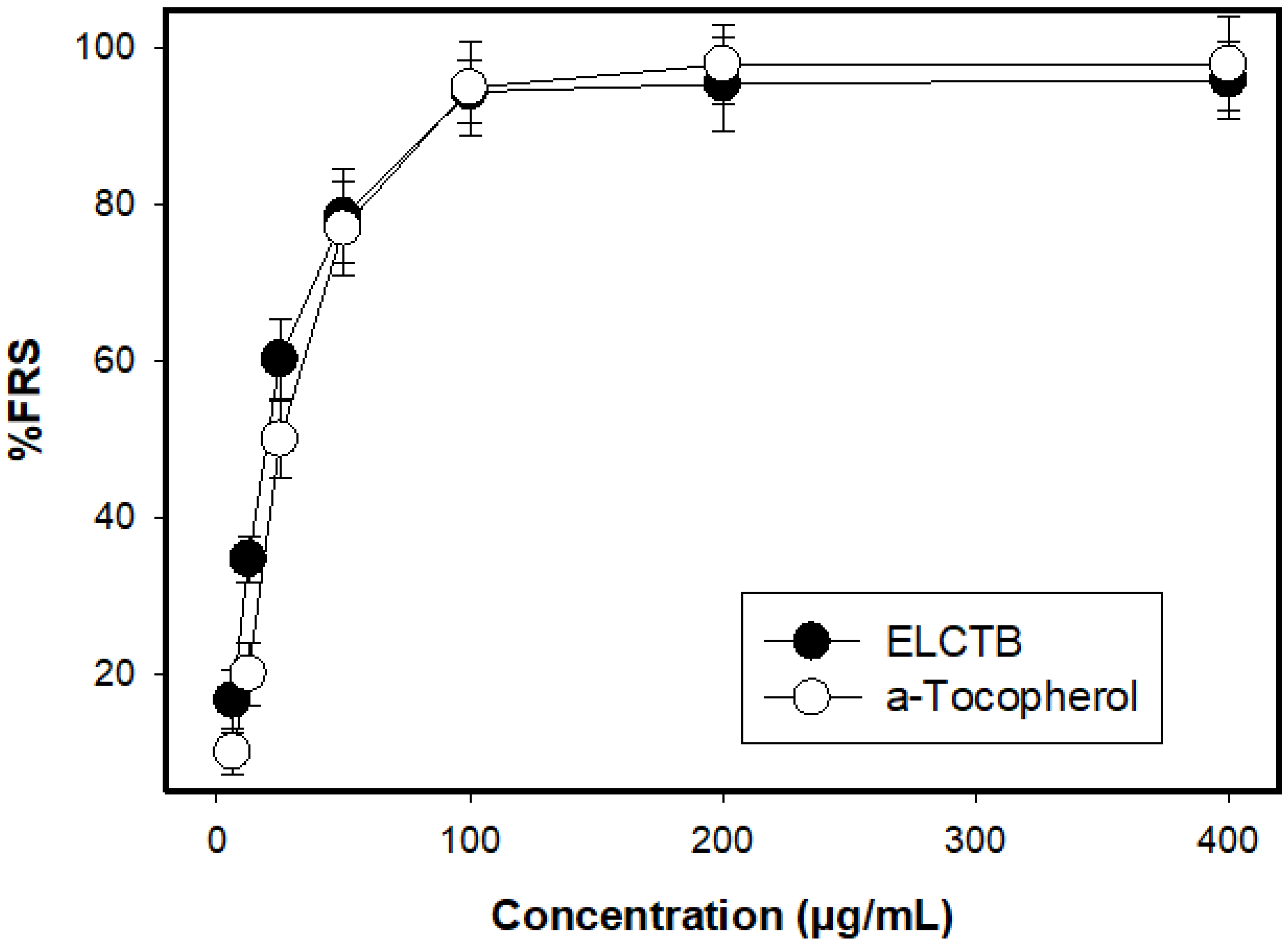
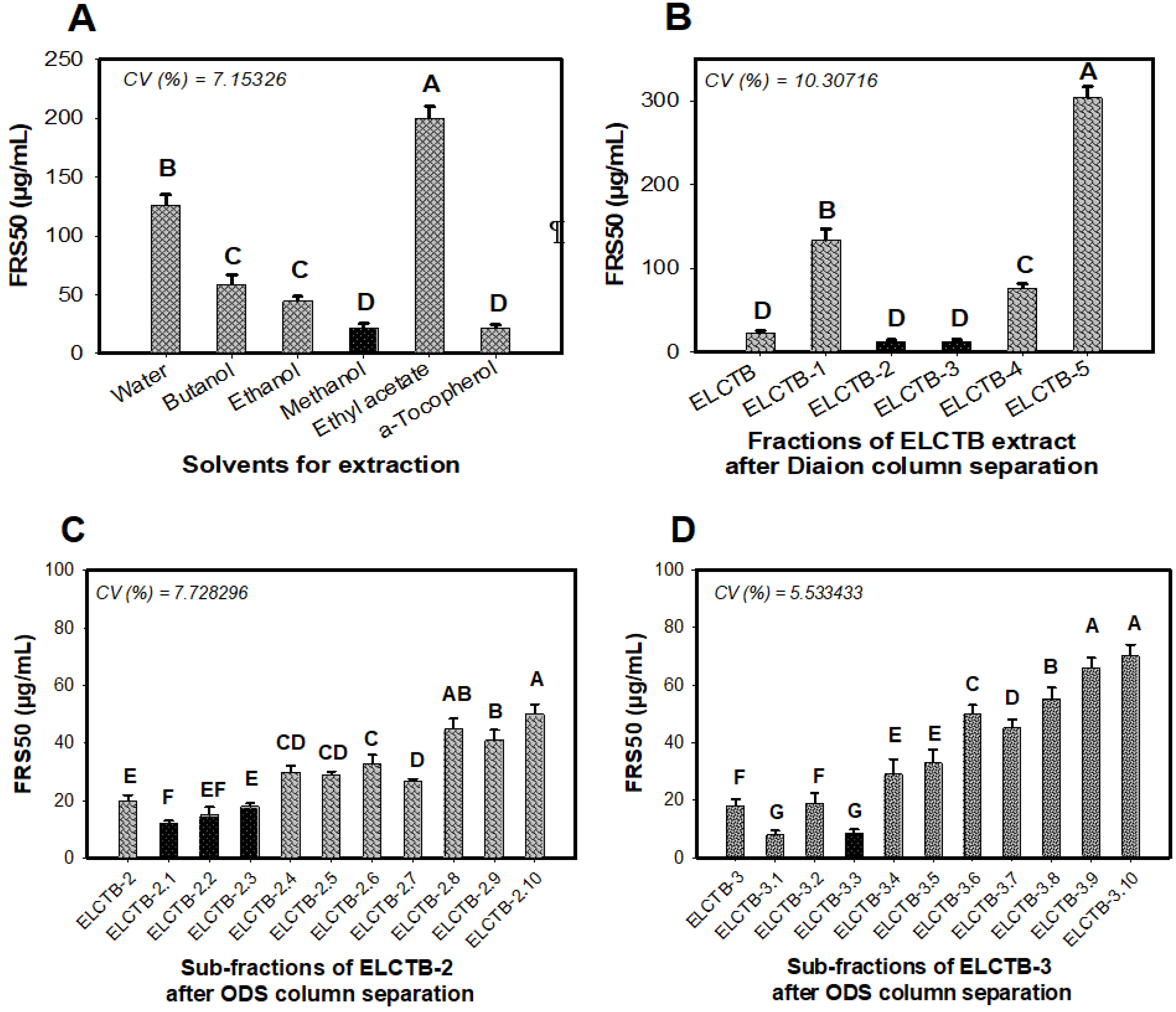
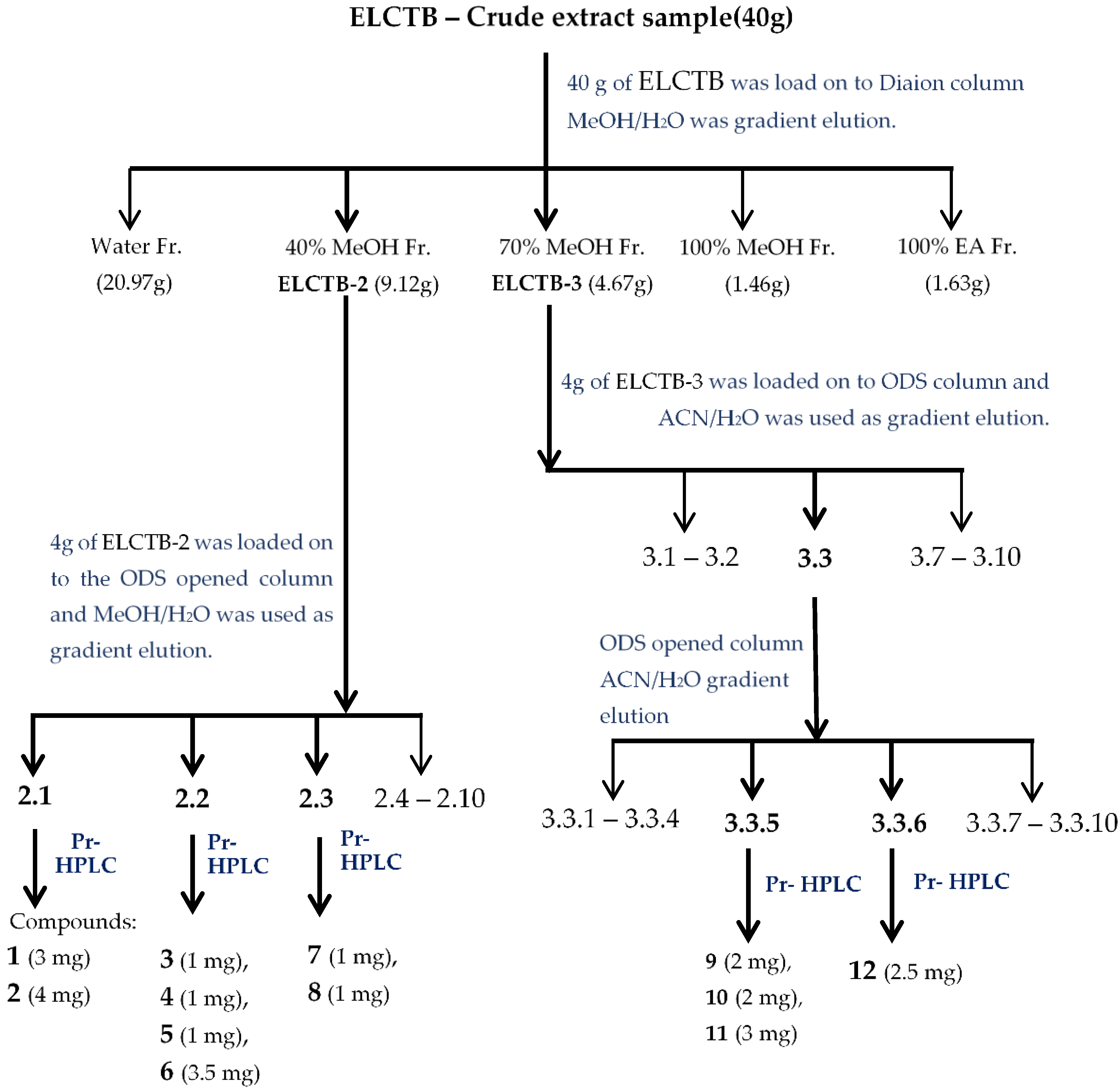
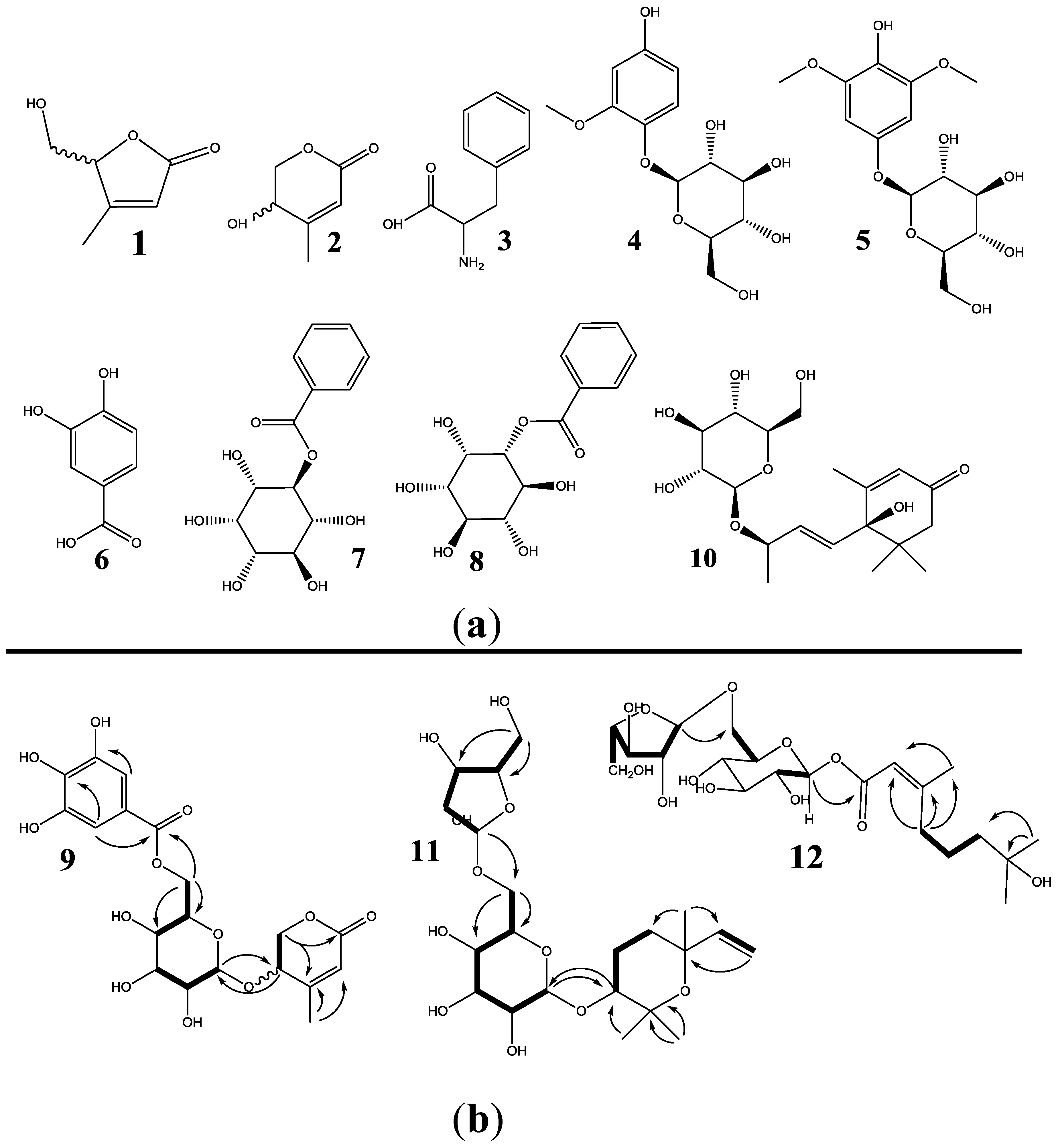
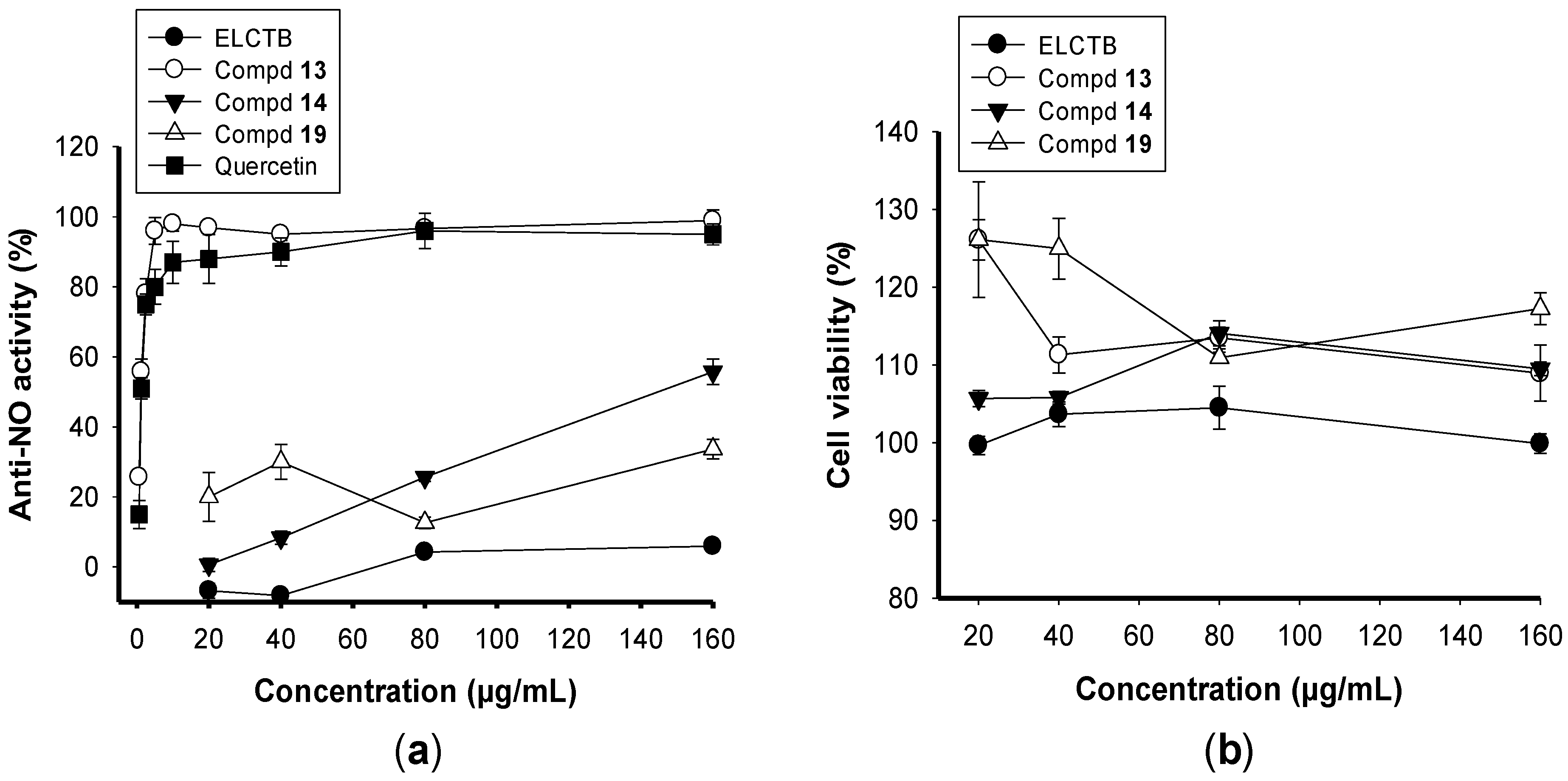
| Scientific Name of Medicinal Plants | Part Used | FRS50 (µg/mL) | Ref. |
|---|---|---|---|
| Euonymus laxiflorus Champ. | Trunk bark | 20.2 ± 0.45 | This study |
| α-Tocopherol * | 24.4 ± 0.87 | ||
| Terminalia alata | Trunk bark | 240 ± 20 | Nguyen et al., 2016 [5] |
| T. bellirica | Trunk bark | 1020 ± 20 | Nguyen et al., 2016 [5] |
| T. corticosa | Trunk bark | 250 ± 0.00 | Nguyen et al., 2016 [5] |
| l-ascorbic acid * | 240 ± 0.00 | Nguyen et al., 2016 [5] | |
| T. nigrovenulosa | Bark extract | 273 ± 3 | Nguyen, Q.V. 2017 [10] |
| T. nigrovenulosa | Leaves extract | 408 ± 6 | Nguyen, Q.V. 2017 [10] |
| No. | Isolated compounds | DPPHFRS50 (μg/mL) | Max (%) |
|---|---|---|---|
| 1 | Umbelactone (new natural product) | - | - |
| 2 | Walterolactone | - | - |
| 3 | Phenylalanine | - | - |
| 4 | 2-methoxy-4-hydroxyphenol-1-O-β-d-glucopyranoside | 38.09 b | 92 a |
| 5 | 1-β-d-glucopyranosyloxy-3,5-dimethoxy-4-hydroxybenzene | 58.11 a | 100 a |
| 6 | 3,4-Dihydroxybenzoic acid | 16.77 e | 95 a |
| 7 | 2-benzoyl myo-inositol (new natural product) | - | - |
| 8 | 1-O-Benzoyl-myo-inositol (new natural product) | - | - |
| 9 | Walterolactone A/B 6-O-gallate-β-d-glucopyranoside (new compound) | 10.9 e,f | 96 a |
| 10 | Roseoside (6S, 9S) | - | - |
| 11 | (3R*,6R*)-tetrahydro-6-ethenyl-2,2,6-trimethyl-2H-pyran 3-O-α-l-arabinopyranosyl (1→3)-β-d-glucuronopyranosyl (new compound) | UD | 25 b |
| 12 | 7-Hydroxy-6,7-dihydro-cis/trans-geraniate, 3-O-α-l-arabinopyranosyl (1→6)-β-d-glucupyranosyl (new compound) | UD | 20 b |
| 13 | Walterolactone A (1a) and B (1b) β-d-glucopyranoside | 28 c,d | 98 a |
| 14 | Gallic acid | 9 f | 97 a |
| 15 | (−)-Gallocatechin | 30.73 c | 93 a |
| 16 | 1-(4-hydroxyphenyl)-2,3-dihydroxypropan-1-one 3-O-β-d-glucopyranoside/or Schweinfurthinol 9-O-β-d-glucopyranoside | - | - |
| 17 | Myo-inositol 1-O-3,3-dimethylacrylate/or 1-O-(3-methyl)-butenoyl-myo-inositol | - | - |
| 18 | Leonuriside | 27.47 c,d | 95 a |
| 19 | (+)-Catechin | 7.10 f | 97 a |
| 20 | Methyl galloate | 9.4 f | 96 a |
| 21 | (−)-Catechin | 11.5 e,f | 96 a |
| 22 | (3,5-dimethoxy-4-hydroxyphenol)-1-O-β-d-(6′-O-galloyl)-glucopyranoside | 7.8 f | 96 a |
| α-Tocopherol (commercial antioxidant) | 23 d | 99 a | |
| CV (Coefficient of variation, %) | 12.33842 | 7.156336 |
© 2018 by the authors. Licensee MDPI, Basel, Switzerland. This article is an open access article distributed under the terms and conditions of the Creative Commons Attribution (CC BY) license (http://creativecommons.org/licenses/by/4.0/).
Share and Cite
Nguyen, V.B.; Wang, S.-L.; Nguyen, A.D.; Lin, Z.-H.; Doan, C.T.; Tran, T.N.; Huang, H.T.; Kuo, Y.-H. Bioactivity-Guided Purification of Novel Herbal Antioxidant and Anti-NO Compounds from Euonymus laxiflorus Champ. Molecules 2019, 24, 120. https://doi.org/10.3390/molecules24010120
Nguyen VB, Wang S-L, Nguyen AD, Lin Z-H, Doan CT, Tran TN, Huang HT, Kuo Y-H. Bioactivity-Guided Purification of Novel Herbal Antioxidant and Anti-NO Compounds from Euonymus laxiflorus Champ. Molecules. 2019; 24(1):120. https://doi.org/10.3390/molecules24010120
Chicago/Turabian StyleNguyen, Van Bon, San-Lang Wang, Anh Dzung Nguyen, Zhi-Hu Lin, Chien Thang Doan, Thi Ngoc Tran, Hung Tse Huang, and Yao-Haur Kuo. 2019. "Bioactivity-Guided Purification of Novel Herbal Antioxidant and Anti-NO Compounds from Euonymus laxiflorus Champ." Molecules 24, no. 1: 120. https://doi.org/10.3390/molecules24010120
APA StyleNguyen, V. B., Wang, S.-L., Nguyen, A. D., Lin, Z.-H., Doan, C. T., Tran, T. N., Huang, H. T., & Kuo, Y.-H. (2019). Bioactivity-Guided Purification of Novel Herbal Antioxidant and Anti-NO Compounds from Euonymus laxiflorus Champ. Molecules, 24(1), 120. https://doi.org/10.3390/molecules24010120










